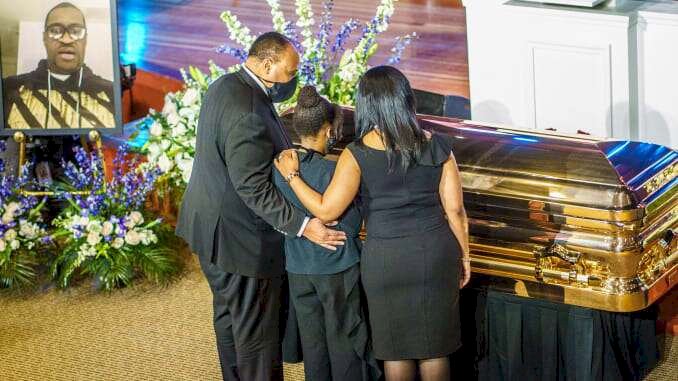A memorial service for George Floyd is a somber moment after days of anger and unrest
The event, at turns somber and defiant, followed more than a week of upheaval around the United States prompted by the video of a white police officer kneeling for almost nine minutes on Mr. Floyd’s neck

The police officer’s knee on George Floyd’s neck — the instrument of his death, prosecutors contend — is a metaphor for the entire African-American experience, the Rev. Al Sharpton declared at an emotional memorial service in Minneapolis on Thursday.
“The reason we could never be who we wanted to be and dreamed of being is you kept your knee on our neck,” Mr. Sharpton said in a sanctuary full of Mr. Floyd’s relatives and friends, along with political and religious leaders, as people around the world watched on television and online.
“It’s time for us to stand up in George’s name and say get your knee off our necks,” he added.
The event, at turns somber and defiant, followed more than a week of upheaval around the United States prompted by the video of a white police officer kneeling for almost nine minutes on Mr. Floyd’s neck as he lay face down and handcuffed on the pavement, saying “I can’t breathe.”
In death, the 46-year-old Mr. Floyd has become a symbol of police brutality. But family members remembered him as the man they knew as Perry, and people in the neighborhood called “Big Floyd,” someone with a gift for making friends and making people feel welcome.
“Everywhere you go and see people, how they cling to him. They wanted to be around him,” said Mr. Floyd’s brother, Philonise.
Even for homeless people and drug addicts, “when they spoke to George, they felt like they was the president, that’s how he made them feel,” Philonise Floyd said.
“Being in the house with my brother, it was inspiring,” he added, “because my mom used to take in other kids, and they were George’s friends.” He spoke of sharing a bed with his big brother, making banana-and-mayonnaise sandwiches, and playing football.
One of his cousins, Shareeduh Tate, said: “The thing I miss most about him is his hugs. He was just this big giant.”
READ ALSO:
Trump claims he went into the White House bunker to carry out an inspection

A mural above the dais of the Frank J. Lindquist Sanctuary at North Central University depicted Mr. Floyd’s face above the words “Now I can breathe.” Behind Mr. Floyd’s gleaming bronze coffin, a choir and musicians filled the room with gospel music.
When Mr. Floyd called out in his last minutes for his late mother, she “was reaching out to him” from beyond, Mr. Sharpton said, welcoming him to “a place where the wicked don’t threaten you.”
Mr. Sharpton pledged that Mr. Floyd’s death would not be forgotten.
“We’re going to keep marching, George,” Mr. Sharpton said. “We’re going to keep fighting, George.”
Before the service began, the Rev. Jesse Jackson, Senators Amy Klobuchar and Tina Smith of Minnesota, Gov. Tim Walz, Mayors Jacob Frey of Minneapolis and Melvin Carter of St. Paul and many others milled about, most of them wearing masks, quietly greeting each other with nods and elbow bumps.
Mr. Frey knelt with one hand on the coffin for minutes, his body heaving and tears on his face.
As the service began, the university president, the Rev. Scott Hagen, announced the creation of the George Floyd Memorial Scholarship, adding that since Mr. Floyd’s death, people had given $53,000 specifically for the education of young black people.
“I’m now challenging every university president in the United States of America to establish your own George Floyd memorial scholarship fund,” he said.
Memorials for Mr. Floyd will also be held on Saturday in Raeford, N.C., and on Monday in Houston.
nytimes






































